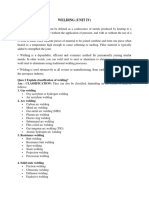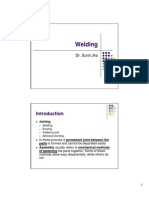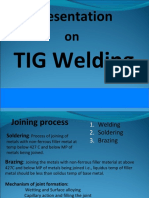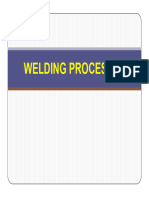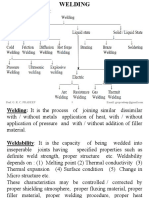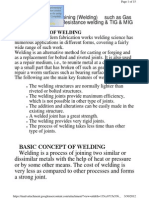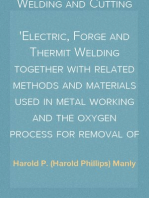0 ratings0% found this document useful (0 votes)
35 viewsWelding: Group D: Tarang Valecha Dhananjay R. Apurva Mali Prateek Singh
Welding: Group D: Tarang Valecha Dhananjay R. Apurva Mali Prateek Singh
Uploaded by
cfcshakerThe document discusses various welding types used in shipbuilding, including gas welding, tungsten inert gas (TIG) welding, and metal inert gas (MIG) welding. Gas welding uses oxygen and acetylene gases to produce a flame over 3,200 degrees C. TIG welding uses a non-melting tungsten electrode and inert gas shield to produce a stable arc weld with a small heat affected zone. MIG welding uses an automatically fed wire and an inert gas shield to produce welds on ferrous and non-ferrous metals.
Copyright:
© All Rights Reserved
Available Formats
Download as PPT, PDF, TXT or read online from Scribd
Welding: Group D: Tarang Valecha Dhananjay R. Apurva Mali Prateek Singh
Welding: Group D: Tarang Valecha Dhananjay R. Apurva Mali Prateek Singh
Uploaded by
cfcshaker0 ratings0% found this document useful (0 votes)
35 views16 pagesThe document discusses various welding types used in shipbuilding, including gas welding, tungsten inert gas (TIG) welding, and metal inert gas (MIG) welding. Gas welding uses oxygen and acetylene gases to produce a flame over 3,200 degrees C. TIG welding uses a non-melting tungsten electrode and inert gas shield to produce a stable arc weld with a small heat affected zone. MIG welding uses an automatically fed wire and an inert gas shield to produce welds on ferrous and non-ferrous metals.
Original Title
Welding - Grp D
Copyright
© © All Rights Reserved
Available Formats
PPT, PDF, TXT or read online from Scribd
Share this document
Did you find this document useful?
Is this content inappropriate?
The document discusses various welding types used in shipbuilding, including gas welding, tungsten inert gas (TIG) welding, and metal inert gas (MIG) welding. Gas welding uses oxygen and acetylene gases to produce a flame over 3,200 degrees C. TIG welding uses a non-melting tungsten electrode and inert gas shield to produce a stable arc weld with a small heat affected zone. MIG welding uses an automatically fed wire and an inert gas shield to produce welds on ferrous and non-ferrous metals.
Copyright:
© All Rights Reserved
Available Formats
Download as PPT, PDF, TXT or read online from Scribd
Download as ppt, pdf, or txt
0 ratings0% found this document useful (0 votes)
35 views16 pagesWelding: Group D: Tarang Valecha Dhananjay R. Apurva Mali Prateek Singh
Welding: Group D: Tarang Valecha Dhananjay R. Apurva Mali Prateek Singh
Uploaded by
cfcshakerThe document discusses various welding types used in shipbuilding, including gas welding, tungsten inert gas (TIG) welding, and metal inert gas (MIG) welding. Gas welding uses oxygen and acetylene gases to produce a flame over 3,200 degrees C. TIG welding uses a non-melting tungsten electrode and inert gas shield to produce a stable arc weld with a small heat affected zone. MIG welding uses an automatically fed wire and an inert gas shield to produce welds on ferrous and non-ferrous metals.
Copyright:
© All Rights Reserved
Available Formats
Download as PPT, PDF, TXT or read online from Scribd
Download as ppt, pdf, or txt
You are on page 1of 16
WELDING
Group D: Tarang Valecha
Dhananjay R.
Apurva Mali
Prateek Singh
List various types of welding used for
shipbuilding and with the aid of simple
sketches, explain three common types of
welding.
Introduction
The processes employed in shipbuilding are
usually of the fusion welding type. It is
achieved by means of a heat source, which is
intense enough to melt the edges of the
material to be joined as it is traversed along
the joint. Gas welding, arc welding and
resistance welding all provide heat sources of
sufficient intensity to achieve fusion welds.
Various types of welding used in
shipbuilding are:
Gas welding
Electric arc welding
Automatic welding with coated wires or cored
wires
Submerged arc welding
Stud welding
Tungsten inert gad welding (T.I.G.)
Metal inert gas welding
Electro-slag welding
Electro-gas welding
Thermit welding
Gas welding
Oxyacetylene welding, commonly referred to
as gas welding, is a process which relies on
combustion of oxygen and acetylene.
When mixed together in correct proportions
within a hand-held torch or blowpipe, a
relatively hot flame is produced with a
temperature of about 3,200 deg.C.
The chemical action of the oxyacetylene flame
can be adjusted by changing the ratio of the
volume of oxygen to acetylene.
Gas welding
Three distinct flame settings are used, neutral,
oxidising and carburising.
Welding is generally carried out using the neutral
flame setting which has equal quantities of oxygen
and acetylene.
The oxidising flame is obtained by increasing just
the oxygen flow rate while the carburising flame is
achieved by increasing acetylene flow in relation to
oxygen flow.
Because steel melts at a temperature above 1,500
deg.C, the mixture of oxygen and acetylene is used
as it is the only gas combination with enough heat to
weld steel.
Gas welding
Neutral flame
Oxidising flame
Carburising flame
Gas welding
However, other gases such as propane,
hydrogen and coal gas can be used for
joining lower melting point non-ferrous
metals, and for brazing and silver soldering.
Oxyacetylene equipment is portable and easy
to use. It comprises oxygen and acetylene
gases stored under pressure in steel
cylinders.
The cylinders are fitted with regulators and
flexible hoses which lead to the blowpipe.
Gas welding
The relationship
between material
thickness, blowpipe
nozzle size and welding
speed, is shown in the
chart.
Tungsten inert gas welding
Frequently used in the welding
of Aluminium brasses, Cunifer,
and stainless steels.
This is a particularly effective
weld process particularly for
the aluminium brasses such
as yorcalbro often found in sea
water systesm.
The small heat effected zone
is particularly important as
super granulation causes a
softening of yorcalbro leading
to bulging and failure under
pressure
Tungsten inert gas welding
The main advantages are :
Easy to use in all positions
Stable welld directed heat with small heat
effected zone and deep penetration
Clean smooth welds of high quality
Tungsten inert gas welding
Technique-The basic technique is a cross between
Stick welding and gas welding. The arc is struck
against the surface, the shield gas is ionised and a
stable arc is formed. The elctrode must be quickly
brought up to the weld height to prevent
contaminationof the weld pool. The tungsten
electrode does not melt. A filler rod of correct
material is introduced in a similar fashion to gas
welding. The electrode holder is held at a 75' angle
and thefiller rod held at 30' in the direction of the
forehand travel.For TIG the shield gas has the
added requirement of preventing oxidation and
cooling the tungsten electrode.
Metal inert gas welding (M.I.G.)
Also called Gas
Metal Arc Welding
(GMAW).
Where CO2 is used
as the shielding gas
the system may also
be known as Metal
Active Gas (MAG).
Generaically the
term MIG is applied
to the welding sets.
Metal inert gas welding (M.I.G.)
The shield for the arc is formed from a supply of inert gas.
Gas stored in a bottle is led via a flow regulator through a tube to the welding
torch.
When the trigger on the torch is depressed firstly the gas valve is opened and
the shield gas emitted from the nozzle.
Further depressing the trigger makes an electrical switch and the wire feed is
activated and the metal wire electrified.
To start the welding operation the torch is held a set distance-sat 10-15mm,
from the work piece, the trigger is pressed and the arc established.
Note that the arc is not 'struck' in the same way as stick welding.
To improve the arc creation is it advisable to sharpen the wire to a point before
starting
Wire Stick out - The amount of wire sticking out of the holder at startup should
be controlled.
Too long and the weld arc is cool and may not be properly shielded by the gas.
Too short and the holder tip can be overheated and weld spatter may enter the
nozzle and cause turbulence in the gas flow
Metal inert gas welding (M.I.G.)
Gasses use for different metals:
Argon
Aluminium
Stainless Steel
Copper and copper alloys
Carbon Dioxide
Ferrous metals
Argon/CO2 mix
Ferrous Metals
Stainles steels
You might also like
- Internship ReportDocument28 pagesInternship ReportSobia Jamil100% (3)
- GAS WELDING REPORT (Mohamad Syazwan Bin Abd Aziz F2029)Document21 pagesGAS WELDING REPORT (Mohamad Syazwan Bin Abd Aziz F2029)Mohd Naqiuddeen Khalil93% (45)
- Gas Welding ReportDocument17 pagesGas Welding ReportNorasilah Chan67% (3)
- Welding WorkshopDocument29 pagesWelding WorkshopAnonymous h5OeGoX3MT100% (1)
- Welding Safety PPT 2Document65 pagesWelding Safety PPT 2cfcshakerNo ratings yet
- Beginner's Guide To Welding 101 - All You Need To Know PDFDocument60 pagesBeginner's Guide To Welding 101 - All You Need To Know PDFisaias.prestesNo ratings yet
- Welding (Unit Iv)Document19 pagesWelding (Unit Iv)Susheel GuptaNo ratings yet
- WeldingDocument90 pagesWeldingAnesu ZirerezaNo ratings yet
- Welding Shop: Fig.1: Classification of Welding ProcessesDocument11 pagesWelding Shop: Fig.1: Classification of Welding Processesfzhxgdj,khNo ratings yet
- Welding: Dr. Sunil JhaDocument21 pagesWelding: Dr. Sunil JharassdriverNo ratings yet
- Material Lab Uet No 14Document7 pagesMaterial Lab Uet No 14m.sheraz malikNo ratings yet
- TME103-Unit4 - ModifiedDocument182 pagesTME103-Unit4 - Modifiedzulazri91No ratings yet
- TIG Presentation.Document31 pagesTIG Presentation.Md Anamul HoqueNo ratings yet
- Lab 6 Gas and Arc Welding: Submitted by Ahmed Suliman Altuwiajri 429105740 Supervised by Eng. SameerDocument17 pagesLab 6 Gas and Arc Welding: Submitted by Ahmed Suliman Altuwiajri 429105740 Supervised by Eng. SameerAhmed SulimanNo ratings yet
- 2.0 WeldingDocument26 pages2.0 Weldingokothbethel2021No ratings yet
- 4 ME 323 Gas WeldingDocument30 pages4 ME 323 Gas WeldingAbdulmuhsen FakihNo ratings yet
- Unit 2: Manufacturing ProcessesDocument93 pagesUnit 2: Manufacturing Processesharshaggarwalofficial1No ratings yet
- Metallic Arc WeldingDocument12 pagesMetallic Arc WeldingBiswanath RoulNo ratings yet
- Arc Welding Process PDFDocument12 pagesArc Welding Process PDFBiswanath RoulNo ratings yet
- Lecture 4Document65 pagesLecture 4Ishtiaq AhmedNo ratings yet
- MP Mod2Document167 pagesMP Mod2Abiram VSNo ratings yet
- Welding Part 3Document59 pagesWelding Part 3JishnuNo ratings yet
- 3a WeldingDocument51 pages3a WeldingArvind GiridharNo ratings yet
- Welding 2 PDFDocument7 pagesWelding 2 PDFPratyush BhattacharyaNo ratings yet
- Ch-19 Gas Welding, Gas Cutting - Arc WeldingDocument85 pagesCh-19 Gas Welding, Gas Cutting - Arc WeldingdiptyaNo ratings yet
- Accurate Institue of Management and Technology-Greater Noida WeldingDocument26 pagesAccurate Institue of Management and Technology-Greater Noida WeldingVipin PachouriNo ratings yet
- Welding and Cutting Process Module-IIIDocument20 pagesWelding and Cutting Process Module-IIIShiba Narayan SahuNo ratings yet
- MP UNIT -2Document36 pagesMP UNIT -2Lakshay AryaNo ratings yet
- Welding 2Document28 pagesWelding 2devadityavikram3No ratings yet
- WeldingDocument54 pagesWeldingAbdullah changNo ratings yet
- Basic Guide To WeldingDocument7 pagesBasic Guide To WeldingJaveed A. KhanNo ratings yet
- Me 6008-Welding Technology (Elective) : Year/ Sem: Iv/ ViiDocument53 pagesMe 6008-Welding Technology (Elective) : Year/ Sem: Iv/ ViiparthibankNo ratings yet
- Advanced Welding Process (Welding)Document58 pagesAdvanced Welding Process (Welding)Sk SamsuddinNo ratings yet
- Internship Report PDFDocument28 pagesInternship Report PDFSobia JamilNo ratings yet
- Welding FundamentalsDocument49 pagesWelding FundamentalsJoNo ratings yet
- Ch-3 - Advanced Welding ProcessesDocument17 pagesCh-3 - Advanced Welding ProcessesNishanta BasisthaNo ratings yet
- 5 GtawDocument45 pages5 GtawPutra Daha PratamaNo ratings yet
- Aircraft WeldingDocument25 pagesAircraft WeldingRodolfo FerreiraNo ratings yet
- Manufacturing Engg. LabDocument34 pagesManufacturing Engg. Labshankarkumar39668No ratings yet
- Assignment in Advance WeldingDocument10 pagesAssignment in Advance WeldingShabbir WahabNo ratings yet
- Gaswelcome: AV.S Ram PrasadDocument50 pagesGaswelcome: AV.S Ram PrasadAkhil MetlaNo ratings yet
- Welding & Gas WeldingDocument18 pagesWelding & Gas WeldingRamanjeet KaurNo ratings yet
- WeldingDocument33 pagesWeldingMuhammad LuqmanNo ratings yet
- Welding Technology NotesDocument89 pagesWelding Technology NotesSanjay JangraNo ratings yet
- Hazards in Welding CuttingDocument18 pagesHazards in Welding CuttingZubair SoomroNo ratings yet
- Unit - 2Document130 pagesUnit - 2prave231205No ratings yet
- WeldingDocument169 pagesWeldingamarparimi100% (2)
- Gas WeldingDocument20 pagesGas WeldingVikas LavaniaNo ratings yet
- Welding and Fabrication Work Piece 2024 - 073619Document22 pagesWelding and Fabrication Work Piece 2024 - 073619olokahboniey18No ratings yet
- Type of WeldingDocument49 pagesType of WeldingShahanNo ratings yet
- Basic Concept of WeldingDocument15 pagesBasic Concept of WeldingAnish KumarNo ratings yet
- Unit 3: Welding: DefinitionDocument20 pagesUnit 3: Welding: DefinitionUtkarsh SharmaNo ratings yet
- Gas WeldingDocument22 pagesGas WeldingShalin Sharma50% (2)
- chapter-7Document9 pageschapter-7TUFAYEL AHMED 1912002No ratings yet
- Welding XXXXXDocument25 pagesWelding XXXXXKentDemeterioNo ratings yet
- Manufacturing Technology: Tig Welding - Process AnalysisDocument8 pagesManufacturing Technology: Tig Welding - Process AnalysisshubhamNo ratings yet
- Unit II-metal Joining ProcessDocument37 pagesUnit II-metal Joining ProcessKEERTHIVASAN R MechNo ratings yet
- Class_1(Types of Welding) (1)Document50 pagesClass_1(Types of Welding) (1)nirabsinha1No ratings yet
- Pointers For Midterm ExamDocument15 pagesPointers For Midterm ExamMark SyNo ratings yet
- Oxy-Acetylene Welding and Cutting Electric, Forge and Thermit Welding together with related methods and materials used in metal working and the oxygen process for removal of carbonFrom EverandOxy-Acetylene Welding and Cutting Electric, Forge and Thermit Welding together with related methods and materials used in metal working and the oxygen process for removal of carbonNo ratings yet
- Introduction To WeldingDocument16 pagesIntroduction To WeldingcfcshakerNo ratings yet
- Welding, Cutting, and BrazingDocument42 pagesWelding, Cutting, and BrazingcfcshakerNo ratings yet
- Welding Defects: Engr Muhammad Hussain Inspection Engineer Global NDE Services Pvt. LTD KarachiDocument12 pagesWelding Defects: Engr Muhammad Hussain Inspection Engineer Global NDE Services Pvt. LTD KarachicfcshakerNo ratings yet
- Welding Symbols 3Document8 pagesWelding Symbols 3cfcshakerNo ratings yet
- Teknologi Dan Rekayasa: Oxy-Acetylene WeldingDocument23 pagesTeknologi Dan Rekayasa: Oxy-Acetylene Weldingcfcshaker100% (1)
- Introduction To Arc WeldingDocument36 pagesIntroduction To Arc WeldingcfcshakerNo ratings yet
- Teknologi Dan Rekayasa: Principles of WeldingDocument23 pagesTeknologi Dan Rekayasa: Principles of WeldingcfcshakerNo ratings yet
- Welding Technology EducationDocument33 pagesWelding Technology EducationcfcshakerNo ratings yet
- Solid-State Welding ProcessesDocument17 pagesSolid-State Welding ProcessescfcshakerNo ratings yet
- Domestic Heating/MMA Welding Unit 3 - Manual Arc WeldingDocument68 pagesDomestic Heating/MMA Welding Unit 3 - Manual Arc WeldingcfcshakerNo ratings yet
- Duplex Stainless Steel WeldingDocument25 pagesDuplex Stainless Steel WeldingcfcshakerNo ratings yet
- Welding Outline &applicationsDocument17 pagesWelding Outline &applicationscfcshakerNo ratings yet
- Weld Joint Geometry and Welding Symbols: Basic Weld Joints Welding Technology Lee Co. AtcDocument15 pagesWeld Joint Geometry and Welding Symbols: Basic Weld Joints Welding Technology Lee Co. AtccfcshakerNo ratings yet
- Welding Drawings 2Document10 pagesWelding Drawings 2cfcshakerNo ratings yet
- Plastic Fasteners Welding BondingDocument28 pagesPlastic Fasteners Welding BondingcfcshakerNo ratings yet
- FRAMED CONNECTION WELD - ModelDocument1 pageFRAMED CONNECTION WELD - ModelEl ClassicoNo ratings yet
- Robotic - WPS Trials Summary 1Document3 pagesRobotic - WPS Trials Summary 1Prabhakaran CHNQualityNo ratings yet
- KÖCO Stud Welding Guns: ClassicDocument2 pagesKÖCO Stud Welding Guns: ClassicGabriel BroascaNo ratings yet
- Weight Per Meter of Weld Metal For Fillet Welds and Elements of Common Butt Joints (KG/M) Steel InstructionsDocument1 pageWeight Per Meter of Weld Metal For Fillet Welds and Elements of Common Butt Joints (KG/M) Steel InstructionsTAMILNo ratings yet
- Welding Map: PROJECT: Repair of Damaged Pipelines & Process Lines - MARETAP - EZZAOUIA FIELDDocument1 pageWelding Map: PROJECT: Repair of Damaged Pipelines & Process Lines - MARETAP - EZZAOUIA FIELDMajdi Jerbi100% (1)
- Radiography Testing RT Acceptance Criteria ASME 9Document3 pagesRadiography Testing RT Acceptance Criteria ASME 9audi100% (1)
- Partager WPS and PQRDocument94 pagesPartager WPS and PQRTahar DabbarNo ratings yet
- SoldaduraDocument6 pagesSoldaduraLerodesNo ratings yet
- Design - Part 3 - TWIDocument9 pagesDesign - Part 3 - TWIFreddie KooNo ratings yet
- ÁDCADocument16 pagesÁDCAthehoang12310No ratings yet
- Stagrwise InspectionDocument30 pagesStagrwise Inspectionshailesh deshmukhNo ratings yet
- WELDING-Root Cause For DefectsDocument10 pagesWELDING-Root Cause For DefectsSiddhardha Msv60% (5)
- Porosity Lack of Fusion Cap Undercut Intermittent Incomplete Filled GrooveDocument10 pagesPorosity Lack of Fusion Cap Undercut Intermittent Incomplete Filled GrooveMuhammad AliNo ratings yet
- CH4 2 Welding Joint PreparationDocument46 pagesCH4 2 Welding Joint PreparationMatija BušićNo ratings yet
- SHS - SLK - Inudstrial Arts Smaw Marking or Locating Weld DefectsDocument20 pagesSHS - SLK - Inudstrial Arts Smaw Marking or Locating Weld Defectsiammhon100% (2)
- Welding Document Print PDFDocument103 pagesWelding Document Print PDFRonneySantosNo ratings yet
- TIME SCHEDULE UpdateDocument16 pagesTIME SCHEDULE UpdateCahyani Permata YpNo ratings yet
- HSD-A-TS-M-DS-0010 - Rev-A01 Mechanical Datasheet For Closed Drain Vessel Immersion HeaterDocument2 pagesHSD-A-TS-M-DS-0010 - Rev-A01 Mechanical Datasheet For Closed Drain Vessel Immersion HeaterThanh Phuc Nguyen100% (1)
- BS en Iso 15614Document13 pagesBS en Iso 15614Hà DũngNo ratings yet
- 1 Las Tvl-Gtaw-Ncii q1 Week1.Docx-finalDocument11 pages1 Las Tvl-Gtaw-Ncii q1 Week1.Docx-finalWilliam EnocNo ratings yet
- Technology Vocational Livelihood: Shielded Metal Arc WeldingDocument9 pagesTechnology Vocational Livelihood: Shielded Metal Arc WeldingjonquintanoNo ratings yet
- Wa0021Document46 pagesWa0021edwinttitusNo ratings yet
- Aws A 5-32Document26 pagesAws A 5-32yelyheyderNo ratings yet
- WPS& WQRDocument132 pagesWPS& WQRAby Jacob Mathews100% (4)
- Electric Current and Its Effects - NoteDocument6 pagesElectric Current and Its Effects - NoteToshit Kumar NaikNo ratings yet
- WeldingDocument23 pagesWeldingSuneel Kumar MeenaNo ratings yet
- AWS A5.10 Specification For Bare Aluminum and Aluminum Alloy Welding Electrodes and Rods (1999)Document38 pagesAWS A5.10 Specification For Bare Aluminum and Aluminum Alloy Welding Electrodes and Rods (1999)Jairo Contreras100% (1)
- 1 Welding Materials Control Procedure PDFDocument3 pages1 Welding Materials Control Procedure PDFMustafa MubderNo ratings yet
- HeyyDocument3 pagesHeyynomoszengNo ratings yet






